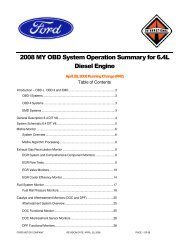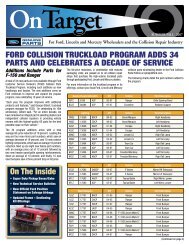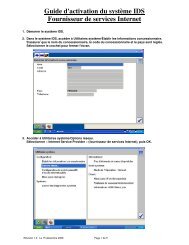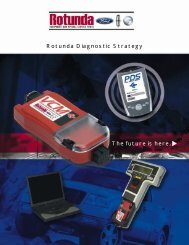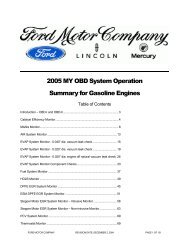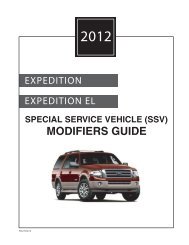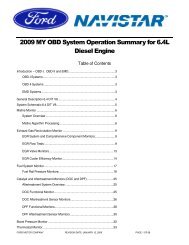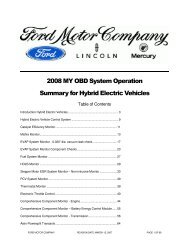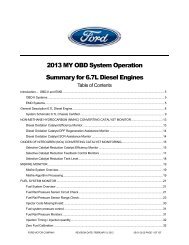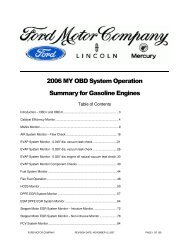OBD Operation Summary for Fiesta - MotorCraftService.com
OBD Operation Summary for Fiesta - MotorCraftService.com
OBD Operation Summary for Fiesta - MotorCraftService.com
- No tags were found...
Create successful ePaper yourself
Turn your PDF publications into a flip-book with our unique Google optimized e-Paper software.
The TPS adaptation includes the following functions:• Adaptation and check of the limp-home position• Adaptation and check of the lower mechanical stop• Lower return spring check• Adaptation of the amplifier amplification (TPS 1 channel)• Upper return spring checkDue to the electrical and the mechanical tolerances of the throttle position system, the sensor characteristic has to belearned. The adaptation and diagnosis of the lower mechanical stop and limp-home position occurs within the adaptationroutines. The adapted lower mechanical stop and the upper check position are used <strong>for</strong> the calculation of TPS channel1. The upper mechanical stop is not learned. During the TPS adaptation no limitation of the throttle position set-point isactive. The learned value <strong>for</strong> the limp-home position, the lower mechanical stop and the TPS channel1 values are storedat the end of each driving cycle as „non-volatile“.The first step is the adaptation of the limp-home position. The actuator is without current and is <strong>for</strong>ced by spring power tothe limp home position. During the adaptation all the voltage values must be in the adaptation windows. A hysteresis isset up around each of the first recorded values (TPS 1 and 2). If all the TPS values are with in this hysteresis during acalibrated time, then the adaptation values are determined from the first and last value <strong>for</strong> each TPS. If a TPS value isoutside the hysteresis, then the process is started over <strong>for</strong> both TPS channels. The learning function is limited by acalibratable time. An adaptation error is detected if the adaptation could not be carried out during the maximum time.The next step is the adaptation of the lower mechanical stop. The throttle is driven into the lower mechanical stop byswitching on the position controller and gradually decreasing the set point. As soon as the mechanical stop is reached,the adaptation of the lower mechanical stop <strong>for</strong> all TPS input channels is started. The adaptation procedure is the sameas the limp-home position except the calibration values are different. As with the limp-home position, if the maximumadaptation time is exceeded, an adaptation error is indicated.Now the lower return spring is checked. The throttle is positioned between lower mechanical stop and limp-home byswitching on the position controller and increasing the set point gradually until a calibrated set point <strong>for</strong> testing the lowerreturn spring is reached. An adaptation error is indicated if the throttle does not reach the requested position in a definedtime limit. Then the ETC power stage is switched off and the throttle has to return by spring power to the limp-homeposition or a return spring error is indicated.Next is the adaptation of the amplification from the TPS measuring amplifier (TPS 1 channel). The controller is switchedon and the set point is gradually increased and the throttle is moved to a position above limp-home until the calibratedset point <strong>for</strong> the adaptation of the measuring amplifier is reached. An adaptation error is indicated if the throttle does notreach the requested position in a defined time limit.The final step is the check of the upper return spring. The throttle is gradually driven further away from limp homeposition until a calibrated set point <strong>for</strong> the upper spring check is reached. An adaptation error will be indicated if thethrottle does not reach the requested position in a defined time limit. The ETC power stage is switched-off and thethrottle has to return by spring power to the limp-home position, or an upper return spring error is indicated.If all of the adaptations and checks pass, the learned value <strong>for</strong> the limp-home position, the lower mechanical stop andthe TPS channel 1 values are stored at the end of each driving cycle in non-volatile memory. This provides the initialcontrol settings <strong>for</strong> the next “Key ON”.CONTINENTAL REVISED: SEPTEMBER 17, 2010 PAGE 80 OF 111



